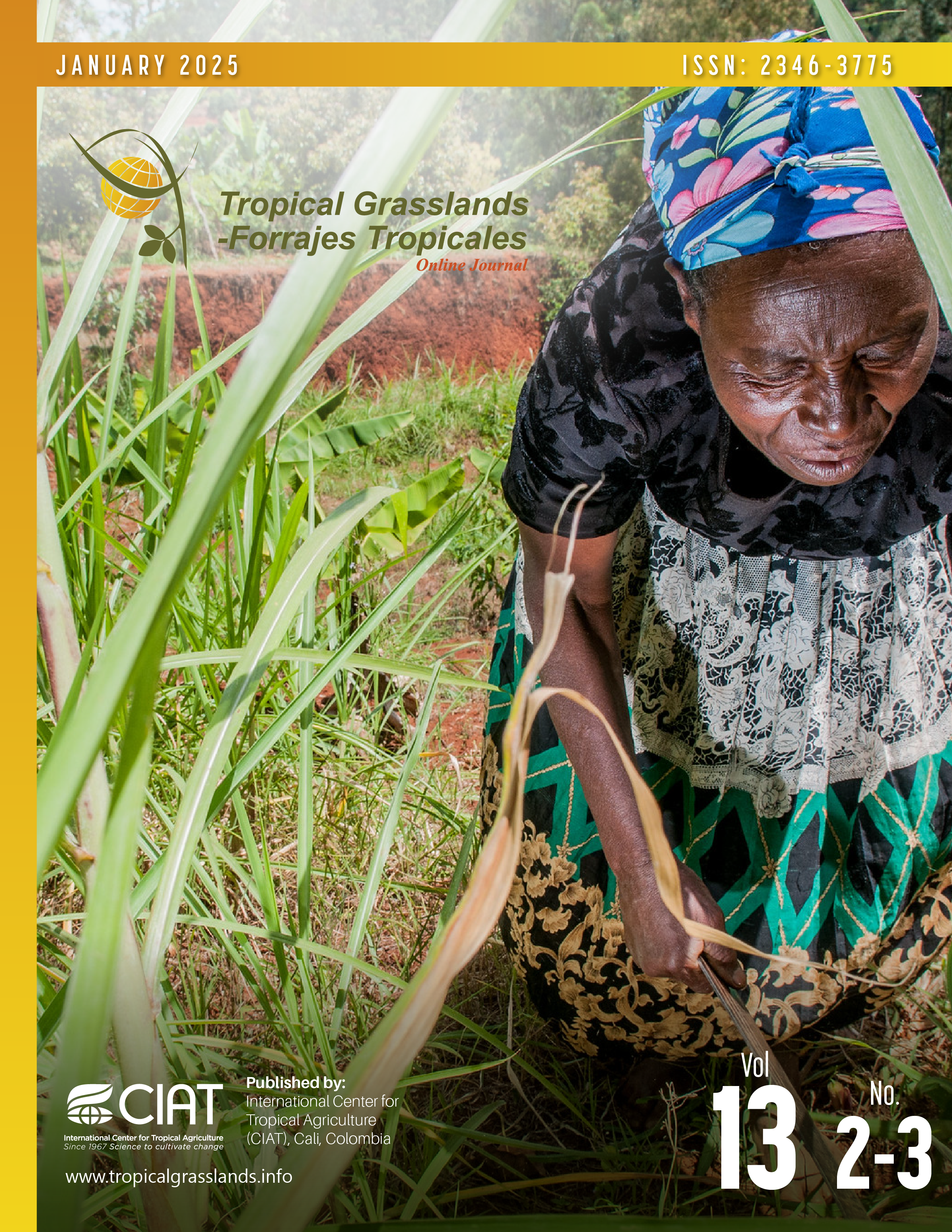Protected urea as a nitrogen source for Mulato II grass: impacts on forage production, feed value and composition
DOI:
https://doi.org/10.17138/tgft(13)82-93Abstract
The growing demand for high-yielding forage cultivars with drought tolerance, broad environmental adaptation and sustained feed quality has stimulated the development of new Urochloa (syn. Brachiaria) genotypes, such as Mulato II. Efficient nitrogen (N) fertilization strategies are essential to optimize their productivity and nutritional value. This study aimed to evaluate the effects of N fertilization, using conventional and protected urea at 0, 50, 100 and 150 kg N/ha on green mass production (GMP), dry matter production (DMP), leaf:stem ratio (LSR), nutritional value, apparent nitrogen recovery (ANR), apparent nitrogen conversion efficiency (ANCE), and crude protein yield per hectare (CP/ha) of Mulato II. The experiment followed a completely randomized 4 × 2 factorial design. The results showed that the N source significantly affected GMP, DMP, neutral detergent fiber (NDF) during the second growth period, and ANCE. Increasing N rates led to higher GMP, DMP and CP concentration, while decreasing ANCE. Fertilization with protected urea improved ANCE and reduced NDF concentration, indicating greater efficiency in nitrogen utilization. These findings support the strategic use of protected urea at moderate N rates to enhance forage productivity and nitrogen use efficiency in Mulato II.
Author Biographies
Reginaldo Jacovetti, Universidade Federal de Goiás
Graduation in Administration from the Araras University Center Dr. Edmundo Ulson (2005). Specialization in Agricultural Management for the Federal University of Goiás (2008). Master in Animal Science in the area of concentration in Animal Production. Administrator of the Fazenda Escola of the Federal University of Goiás in the period from 2006 to 2009, being this producer of literature with the assistance, training and training of students, technicians and rural producers in the macro region of Goiânia. Doctorate in Zootechnics (Forragulture) by the Escola de Veterinária e Zootecnia da UFG, currently awarded to the Department of Zootechnics DZO/EVZ/UFG.
Aldi Fernandes de Souza França, Universidade Federal de Goiás
He graduated in Zootechnics from the Federal University of Rio de Janeiro (1974), mastered in Zootechnics from the Paulista State University Júlio de Mesquita Filho (1980) and graduated in Agronomy (Soles and Plant Nutrition) from the University of São Paulo (1987). Currently he is a full professor at the Federal University of Goiás. He has experience in the area of Animal Husbandry, with an emphasis on Pasture and Forage, focusing mainly on the following topics: pennisetum glaucum, nitrogen adubação, crude protein, bromatological composition and forage.
Débora de Carvalho Basto, Universidade Federal de Goiás
Zootechnician for the Pontifical Catholic University of Goiás (PUC-GO). Possui graduate in Animal Science from the Federal University of Goiás (UFG) and PhD from the Post-Graduation Program in Animal Science and Pastagens of ESALQ/USP. She completed her training program with a group led by Dr. Lynn E. Sollenberger from the Department of Agronomy of the University of Florida / USA. She has experience as a professor at the State University of Goiás (UEG) and the Federal University of Goiás (UFG). In research she operates on topics linked to aspects of applied physiology in the production of forage in pastures, evaluation and conservation of forage plants, forage production and animal production.
Leonardo Guimarães de Oliveira, SJC Bioenergia
Area of knowledge in Veterinary Medicine: Animal Production, Animal Nutrition, Beef Cattle, Forage Farming, Animal Physiology, Pathology, Food and Feeding, Biochemistry of ruminants, Metabolism, Statistics applied to agriculture, Muscle physiology and meat quality.
Renata Vaz Ribeiro, Universidade Federal de Goiás
Zootechnician from the State University of Goiás - UEG. Specialist in Quality Management and Food Safety - UEG. Master in Animal Science, concentration area Animal Production from the Federal University of Goiás (UFG). PhD student in Animal Science - UFG. Professor of the subjects: Animal Genetic Improvement and Management in Animal Production II at Centro Universitário Araguaia - UniAraguaia; Dairy cattle farming and beef cattle farming at the Paula Pasquali Technological Center - CTPP. Area of activity and studies linked to food quality, well-being, environment and management of ruminants.
Mirella Paula Costa e Silva, Universidade Federal de Goiás
Graduated in Animal Science from the Federal University of Goiás- UFG (2020) where she was a scholarship student in the Institutional Program for Scientific Initiation Scholarships (PIBIC) by the National Council for Scientific and Technological Development (CNPq) for two years (2015/2017). She was an intern at the animal nutrition laboratory at UFG (2015/2017), at the food and water microbiology laboratory at UFG (2017/2019), and in which she participated and carried out several bromatological and microbiological analyzes in the area of food production and technology. foods. During her internship, she worked as a quality inspector in a beef slaughterhouse for the company Norvida (2020). She has experience in the area of Animal Husbandry, working mainly with management of control and quality assurance in agro-industries, as a quality analyst in a cattle slaughterhouse and a quality assistant in a broiler feed factory.
Ana Christina Sanches
Professor since 1999, she received a PhD in Animal Science from the Federal University of Goiás (UFG) in 2006, with a Capes sandwich scholarship at the University of California, Davis (UCDavis - USA). Master in Animal Genetics from the University of São Paulo (USP) in 1999, Capes scholarship holder. Graduated in Biological Sciences from the State University of Londrina (UEL) in 1994, where she received a CNPq Scientific Initiation Scholarship. She began her activities at PUC Goiás in the Department of Animal Science, where she was a public assistant professor for 21 years. She was Technical Director of the Research Support Foundation of the State of Goiás (FAPEG) from 2011 to 2014. She served as General Coordinator of the Stricto Sensu Postgraduate Course at PUC Goiás, in the Dean of Postgraduate Studies and Research (PROPE) from 2008 to 2014. She was the Pedagogical Coordinator of the Animal Science Course, coordinator of the Laboratories of that Department, as well as taking on other coordination roles at the School of Agricultural and Biological Sciences. She was also a teacher and advisor in the master's degrees in Genetics, Aquaculture, and the master's degree in Ecology and Sustainable Production and also taught classes in the Agronomy Course. After a year in the USA on sabbatical, she left PUC Goiás in July 2019, and upon her immediate return, she provided educational services as Advisor to the Rectory of Centro Universitário Moura Lacerda. During the pandemic, she owned an açaí franchise for 18 months, returning to teaching as a bilingual elementary school teacher in the International Program at the Liceu Albert Sabin school.
Emmanuel Arnhold, Universidade Federal de Goiás
He has a degree in Agricultural Engineering from the Federal University of Viçosa (2002), a Master's degree in Genetics and Breeding from the Federal University of Viçosa (2004) and a PhD in Genetics and Breeding from the Federal University of Viçosa (2006). He was Adjunct Professor at the Federal University of Maranhão (UFMA), at the Agricultural and Environmental Sciences Campus (CCAA), between 2006 and 2010. He is currently Associate Professor 4 at the Federal University of Goiás (UFG). He teaches statistics applied to agricultural experimentation at undergraduate and postgraduate levels. In the field of research and technological development, he is interested in the development of statistical analyzes applied to agricultural and biological systems. He also collaborates with researchers, assisting in the experimental planning stages and data analysis and interpretation. He participates in the Postgraduate courses in Animal Science and Zootechnics at UFG. He supervises and co-supervises postgraduate students. He is part of the editorial committee of the Revista Trópica-Ciências Agrárias e Biológicas and the magazine Ciência Animal Brasileira (CAB). He has experience with R software. The main areas of research and development are: computational statistics, development of packages in the R environment, experimental planning and statistics applied to agricultural systems.
Reginaldo Nassar Ferreira, Universidade Federal de Goiás
He has a degree in Veterinary Medicine from the Federal University of Goiás (1985), a master's degree in Animal Science from the Federal University of Lavras (1988) and a PhD in Animal Science from the Faculty of Agricultural and Veterinary Sciences Campus de Jaboticabal (2001). He is currently a full professor at the Federal University of Goiás. He has experience in the area of Physiology, with an emphasis on Digestion Physiology, working mainly on the following topics: animal nutrition, enzymes, additives, ruminal degradability, ruminal pH, ruminal NH3 release, Meton and Rumen SCFA, digestibility, digestive system hormone, ghrelin, compensatory gain, methionine for ruminants, probiotics, prebiotics intestinal mucosa, intestinal permeability, rumen and intestine metabarcoding.
References
Alves ESG. 2016. Produtividade, composição bromatologica e dinâmica do perfilhamento da Brachiaria hibrida Convert HD364 sob alturas de corte. MSc Thesis. Universidade Federal de Goiás, Goiânia, Brasil. handle/tede/5593
AOAC (Association Of Analitical Chemists). 2019. Official methods of analysis of AOAC international. 21st edition. AOAC, Washington, DC, USA.
Austin AT; Bustamante MMC; Nardoto GB; Mitre SK; Perez T; Ometto JPHB; Ascarrunz NL; Forti MC; Longo K; Gavito ME; Enrich-Prast A; Martinelli LA. 2013. Latin America’s nitrogen challenge. Science 340(6129):149. doi: 10.1126/science.1231679
Cantarella H. 2007. Nitrogênio. In: Novais RF; Alvarez VH; Barroz NF de; Fontes RL; Cantarutti RB; Neves JC, eds. 2007. Fertilidade do solo. Sociedade Brasileira de Ciência do Solo, Viçosa, Minas Gerais, Brasil. p. 375–470.
Cantarino MA. 2017. Efeito do nitrogênio na mediação da tolerância de Brachiaria ruziziensis À Mahanarva spectabilis (Distant, 1909) (Hemiptera: Cercopidae). MSc. Thesis. Universidade Federal de Juiz de Fora, Juiz de Fora, Brazil. handle/ufjf/5871
Carvalho FJ; Elias RB; Silva AA; Campos TS. 2018. Sources and dosages of nitrogen applied with urea coated with polymers in Marandu Palisade Grass. Revista Agrogeoambiental 10(3):135–143. doi: 10.18406/2316-1817v10n320181189
Carvalho MM; Saraiva OF. 1987. Resposta do capim gordura (Melinis minutiflora Beauv.) a aplicações de nitrogênio em regime de cortes. Revista Brasileira de Zootecnia 16: 442–445.
Chagas PHM das; Gouveia GCC; Costa GGS da; Barbosa WFS; Alves AC. 2017. Volatilization of ammonia in pasture fertilized with nitrogen sources. Revista de Agricultura Neotropical 4(2):76–80. (In Portuguese). doi: 10.32404/rean.v4i2.1301
Delevatti LM; Cardoso AS; Barbero RP; Leite RG; Romanzini EP; Ruggieri AC; Reis RA. 2019. Effect of nitrogen application rate on yield, forage quality, and animal performance in a tropical pasture. Scientific Reports 9:7596. doi: 10.1038/s41598-019-44138-x
Dias MAR. 2016. Desempenho agronômico do milho com diferentes fontes e doses de nitrogênio. MSc. Thesis. Universidade Federal de Uberlândia, Uberlândia, Brasil. handle/123456789/17738
Duarte ALM. 2012. Efeito da água sobre o crescimento e o valor nutritivo das plantas forrageiras. Pesquisa e tecnologia 9(2):1–6. handle/123456789/251
Dubreuil V; Fante KP; Planchon O; Sant’anna JL. 2018. The types of annual climates in Brazil: an application of the classification of Köppen from 1961 to 2015. Confins 37. (In Portuguese). doi: 10.4000/confins.15738
Dupas E; Buzetti S; Rabelo FHS; Sarto AL; Cheng NC; Teixeira Filho MCM; Galindo FS; Dinalli RP; Gazola RN. 2016. Nitrogen recovery, use efficiency, dry matter yield, and chemical composition of palisade grass fertilized with nitrogen sources in the Cerrado biome. Australian Journal of Crop Science 10(9):1330–1338. doi: 10.21475/ajcs.2016.10.09.p7854
Espindula MC; Rodovalho GM; Marcolan AL; Barberena IM; Cipriani HN; Araújo LFB de. 2021. Ammonia loss from protected urea in soil under different irrigation depths. Acta Scientiarum. Agronomy 43(1):e46764. doi: 10.4025/actasciagron.v43i1.46764
Faria BM; Morenz MJF; Paciullo DSC; Lopes FCF; Gomide CAM. 2018. Growth and bromatological characteristics of Brachiaria decumbens and Brachiaria ruziziensis under shading and nitrogen. Revista Ciência Agronômica 49(3):529–536. doi: 10.5935/1806-6690.20180060
Faria DA de; Avelino ACD; Cabral CEA; Abreu JG de; Barros LV de; Cabral CHA; Dantas VGV; Guarnieri SF; Neto AB; Assis LMB. 2019. Investigating the optimal day for nitrogen fertilization on piatã palisadegrass and quênia guinea grass after defoliation. Journal of Experimental Agriculture International 34(6):1–11. doi: 10.9734/jeai/2019/v34i630192
Fernandes EG; Coalho MR. 2018. Effect of growing nitrogen doses on the development of Brachiaria ruziziensis. Revista Terra & Cultura: Cadernos de Ensino e Pesquisa 34:189–201. bit.ly/4mwkCxb
Galindo FS; Buzetti S; Teixeira Filho MCM; Dupas E; Ludkiewicz MGZ. 2017. Application of different nitrogen doses to increase nitrogen efficiency in Mombasa guinegrass (Panicum maximum cv. mombasa) at dry and rainy seasons. Australian Journal of Crop Science 11(12):1657–1664. doi: 10.21475/ajcs.17.11.12.pne907
Gastal F; Belanger G; Lemaire G. 1992. A model of the leaf extension rate of tall fescue in response to nitrogen and temperature. Annals of Botany 70(5):437–442. doi: 10.1093/oxfordjournals.aob.a088500
Guerra GL; Becquer T; Vendrame PRS; Galbeiro S; Brito OR; Silva LDF da; Felix JC; Lopes MR; Henz ÉL; Mizubuti IY. 2019. Nutritional evaluation of Brachiaria brizantha cv. Marandu cultivated in soils developed from basalt and sandstone in the state of Paraná. Semina: Ciências Agrárias 40(1):469–484. doi: 10.5433/1679-0359.2019v40n1p469
Hunegnaw B; Mekuriaw Y; Asmare B; Mekuriaw S. 2022. Morphoagronomical and nutritive performance of Brachiaria grasses affected by soil type and fertilizer application grown under rainfed condition in Ethiopia. Advances in Agriculture 2022:373145. doi: 10.1155/2022/7373145
Lee M; Wycislo A; Guo J; Lee DK; Voigt T. 2017. Nitrogen fertilization effects on biomass production and yield components of miscanthus × giganteus. Frontiers in Plant Science 8:544. doi: 10.3389/fpls.2017.00544
Maranhão CMA; Silva CCF da; Bonomo P; Pires AJV. 2009. Produção e composição químico-bromatológica de duas cultivares de bromatológica de duas cultivares de braquiária adubadas com nitrogênio e sua relação com o índice SPAD. Acta Scientiarum. Animal Sciences 31(2):117–122. doi: 10.4025/actascianimsci.v31i2.4305
Marques DLL; França AFS; Oliveira LG; Arnhold E; Ferreira RN; Correa DSS; Bastos DC; Brunes LC. 2017. Production and chemical composition of hybrid Brachiaria cv. Mulato II under a system of cuts and nitrogen fertilization. Bioscience Journal 33(3):685–696. doi: 10.14393/BJ-v33n3-32956
Martha Junior GB; Vilela L; Sousa DMG de, eds. 2007. Cerrado: Uso eficiente de corretivos e fertilizantes em pastagens. Embrapa Cerrados, Planaltina, Brazil. handle/doc/1113533
Medeiros MDON; Oliveira FHT de; Preston W; Paiva MRFC; Góis HMMN. 2021. Comparison of methods for extracting available phosphorus from soils of the semi-arid. Revista Ciência Agronômica 52(4):e20207633. doi: 10.5935/1806-6690.20210062
Mertens D. 1997. Creating a system for meeting the fiber requirements of dairy cows. Journal of Dairy Science 80(7):1463–1481. doi: 10.3168/jds.S0022-0302(97)76075-2
Oliveira VS; Morais JAS; Fagundes JL; Irla GSL; Santana JCS; Santos CB dos. 2016. Efeito da irrigação na produção e qualidade de pastagens durante o período da seca. Revista Cientifica e Medicina Veterinaria 26:1–10. bit.ly/48pxku8
Paśmionka IB; Bulski K; Boligłowa E. 2021. The participation of microbiota in the transformation of nitrogen compounds in the soil—A review. Agronomy 11(5):977. doi: 10.3390/agronomy11050977
Pequeno DNL; Pedreira CGS; Boote KJ. 2014. Simulating forage production of Marandu palisade grass (Brachiaria brizantha) with the CROPGRO-Perennial Forage model. Crop & Pasture Science 65(12):1335–1348. doi: 10.1071/CP14058
Pereira LET; Sousa LJ de; Bertipaglia LMA; Herling VR; Tech ARB. 2021. Critical concentration and management of nitrogen fertilization in the establishment of Brachiaria hybrid Mavuno. Revista Ciência Agronômica 52(4):e20207625. doi: 10.5935/1806-6690.20210052
Primavesi AC; Primavesi O; Corrêa LA; Cantarella H; Silva AG da; Freitas AR de; Vivaldi LJ. 2004. Nitrogen fertilization in coastcross grass: Effects on nutrient extraction and apparent nitrogen recovery. Revista Brasileira de Zootecnia 33(1):68–78. (In Portuguese). doi: 10.1590/S1516-35982004000100010
R Core Team. 2023. R: A language and environment for statistical computing. R Foundation for Statistical Computing, Viena, Austria. www.r-project.org/
Ransom CJ; Jolley VD; Blair TA; Sutton LE; Hopkins BG. 2020. Nitrogen release rates from slow- and controlled-release fertilizers influenced by placement and temperature. PLOS ONE 15(6):e0234544. doi: 10.1371/journal.pone.0234544
Roberto ARJ. 2007. KimCoat - Uma nova ferramenta para otimização do uso de fertilizantes. Informações Agronômicas 117:13–14. bit.ly/4nGw5ei
Rütting T; Aronsson H; Delin S. 2018. Efficient use of nitrogen in agriculture. Nutrient cycling in agroecosystems 110(1):1–5. doi: 10.1007/s10705-017-9900-8
Santos HG dos; Jacomine PKT; Anjos LHC dos; Oliveira VA de; Lumbreras JF; Coelho MR; Almeida JA de; Araujo Filho JC de; Oliveira JB de; Cunha TJF. 2018. Sistema Brasileiro de Classificação de Solos. 5th edition. Embrapa Solos, Rio de Janeiro, Brazil. handle/doc/1094003
Silva VJ; Pedreira CGS; Sollenberger LE; Silva LS; Yasuoka JI; Almeida ICL. 2016. Canopy height and nitrogen affect herbage accumulation, nutritive value, and grazing efficiency of “Mulato II” Brachiaria grass. Crop Science 56(4):2054–2061. doi: 10.2135/cropsci2015.12.0764
Silva AS; Lima VMM; Trindade JS; Silva VL. 2018. Adubação nitrogenada em diferentes híbridos de Brachiaria brizantha. Scientific Eletronic Reports 11(1):50–56. bit.ly/4nGirYC
Souza EMB de; Rocha WSD da; Soares NA; Martins CE; Sobrinho FS; Almeida MIV de; Rodrigues PR; Moreira GR. 2021a. Water deficit tolerance in genotypes of Urochloa spp. Revista de Ciências Agrárias 44(2–3):127–136. doi: 10.19084/rca.21314
Souza JMA; Silva MS; Ferraz RA; Modesto JH; Ferreira RB; Bolfarini ACB; Tecchio MA; Leonel S. 2021b. The use of hydrogen cyanamide or nitrogen fertilizer increases vegetative and productive performance of fig cv. Roxo de Valinhos. Acta Scientiarum. Agronomy 43:e50519. doi: 10.4025/actasciagron.v43i1.50519
Teixeira RNV; Pereira CE; Kikuti H; Deminicis B. 2018. Brachiaria brizantha (Syn. Urochloa brizantha) cv Marandu under different doses of nitrogen and phosphorus in Humaitá-AM, Brazil. Pesquisa Aplicada & Agrotecnologia 11(2):35–41. doi: 10.5935/PAeT.V11.N2.04
van der Ploeg RR; Bohm W; Kirkham MB. 1999. On the origin of the theory of mineral nutrition of plants and the Law of the Minimum. Soil Science Society of American Journal 63(5):1055–1062. doi: 10.2136/sssaj1999.6351055x
Van Soest PJ. 1994. Nutritional ecology of the ruminant. Cornell University Press, New York, USA.
How to Cite
Downloads
Downloads
Published
Issue
Section
License
Copyright (c) 2025 Tropical Grasslands-Forrajes Tropicales

This work is licensed under a Creative Commons Attribution 4.0 International License.




